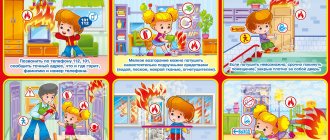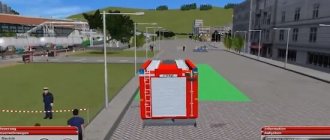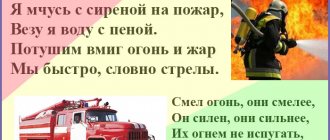Publications about the preparation and conduct of classes on fire safety. We strengthen children's knowledge about the causes of fires, safety rules at home and on the street. We form ideas about the benefits and harms of fire. We teach children to find the right way out of dangerous situations. We systematize their knowledge about what burns and what doesn’t burn. We make children want to be careful with fire always and everywhere. We cultivate responsibility for ourselves and for the lives of our loved ones. See what ways your colleagues have found to present material on fire safety in an entertaining way.
Introduction
Fire safety is one of the components of ensuring the national security of the country. A high level of fire safety is an integral component of the high level of socio-economic development of the Russian Federation. Fires cause significant material damage in all sectors of the national economy, leading to injuries and deaths.
In the Russian Federation, more than 130 thousand fires are recorded annually, as a result of which more than 8 thousand people die, the total losses amount to more than 100 billion rubles. The main causes and objects of fires are presented in the figure below.
The most important and obvious fire safety problem to be resolved, along with increasing the efficiency of the actions of fire departments of various types, is also increasing the effectiveness of preventive fire prevention measures and measures taken by citizens and owners to protect property from fire. Correct and timely work in this direction should have an important socio-economic effect in the form of voluntary and comprehensive compliance with fire safety requirements both personally by citizens and by enterprises, institutions and organizations within the framework of official or public activities.
Achieving this global goal is possible only if a high level of training is provided to the country's population in fire safety measures , which, in accordance with Article 1 of the Federal Law of December 21, 1994 No. 69-FZ “On Fire Safety” [1] refers to actions to ensure fire safety, including compliance with fire safety requirements. At the same time, fire safety requirements are special conditions of a social and (or) technical nature established in order to ensure fire safety by the legislation of the Russian Federation, regulatory documents or an authorized state body [1].
A special role in this process is given to managers and persons responsible for ensuring fire safety of organizations, who not only formulate the organization’s policy in the field of fire safety, develop and implement fire safety measures for a specific enterprise, but also have the right to independently train the rest of the employees of this enterprise in measures fire safety as part of fire safety instructions.
This course is intended for managers and persons responsible for ensuring fire safety in institutions (offices).
Fire safety training program: who develops it and based on what documents
Introductory and primary fire safety training programs must be developed and approved by the head of the organization. Repeated briefings are carried out according to the initial briefing program. Instructions in the organization are carried out by persons appointed responsible for ensuring fire safety.
Instructions on fire safety measures are drawn up in accordance with the requirements established by Section XVIII of the PPR, taking into account the specifics of explosion- and fire-hazardous premises in the specified buildings and structures.
A training program in the scope of PTM is developed by training organizations and approved by the territorial departments of the Russian Ministry of Emergency Situations.
For workers in explosion- and fire-hazardous industries, it is mandatory to include training at testing sites in the PTM program. Therefore, it is impossible to conduct training in PTM for such industries exclusively in theoretical and especially in distance form. To do this, the training organization needs to develop a training ground.
Main causes of fires
To successfully carry out fire prevention in enterprises, it is important to know the main causes of fires. Based on statistical data, we can conclude that the main causes of fires in production are:
— careless handling of fire;
— unsatisfactory condition of electrical devices and violation of the rules for their installation and operation;
— violation of technological process regimes;
— malfunction of heating devices and violation of the rules of their operation;
— failure to comply with the requirements of regulatory documents on fire safety issues.
Very often, industrial fires occur due to careless handling of fire. This usually means smoking in prohibited places and performing so-called hot work. Hot work is considered to be production operations involving the use of open fire, sparking and heating of parts, equipment, structures to temperatures capable of causing ignition of flammable substances and materials, vapors of flammable liquids. Hot work includes: gas and electric welding, gasoline and gas cutting, soldering work, cooking bitumen and resin, mechanical processing of metal with the formation of sparks.
Places for hot work can be permanent or temporary. Permanent places are determined by order of the head of the enterprise, and temporary places - by written permission of the head of the department. In accordance with fire safety requirements, there should be no flammable materials at the hot work sites within a radius of at least 5 m. It must be borne in mind that gas welding uses substances (acetylene, methane, oxygen) that increase the risk of fire and explosion.
Performers of work (electric and gas welders, soldering irons, resin cookers, etc.) must be instructed about fire safety measures by the persons responsible for this.
Before carrying out temporary fire work, fire safety measures are developed, the fire department is notified, persons responsible for ensuring fire safety are appointed, and after that a signed permit for the work is issued. This permission is given for one shift. After finishing hot work, the welder is obliged to inspect the work site and pour water on the combustible structures. The hot work site must be checked repeatedly within 2 hours after completion of work. Before welding a container in which liquid fuel or flammable gases were stored, it should be cleaned, washed with hot water and caustic soda, steamed, dried, ventilated, and an air analysis done. When welding, hatches and caps of the container must be open.
Responsibility for fire safety measures during welding and other hot work rests with the managers of sections, workshops, and enterprises.
According to statistics, fires that occur as a result of the unsatisfactory condition of electrical devices and violation of the rules for their installation and operation account for more than 25% of all cases, and depending on the causes, they are distributed as follows: about 45% occur due to short circuits, 35% - from electric heating devices, 13% - from overload of electric heaters and networks, 5% - from high transient resistances. Short circuits occur due to improper installation or operation of electrical installations, aging or damaged insulation. The short circuit current depends on the power of the current source, the distance from the current source to the fault location and the type of fault. Short circuits cause genuine heating of conductive parts, which can result in ignition of the insulation of conductors and combustible building structures. Overloads in electrical networks occur when additional consumers are connected to the network or when the voltage in the network decreases. Due to a significant increase in current consumption, excessive heating of the conductors occurs, which can cause fires.
An increase in local transient resistance occurs due to oxidation or insufficiently tight connection of the contacts of electrical machines. The resulting spark may start a fire. To prevent fire from high transition resistances, copper wires and cables are connected by twisting the cores and then soldering them. Aluminum cables are connected with sleeves.
The choice of electrical wiring diagrams, materials used, cross-sectional area of conductors and cables, type of insulation depends on the degree of fire hazard of the environment, operating mode of electrical installations and possible overloads: The cross-sectional area of conductors is selected according to the norms of permissible current loads and voltage drop in the network. Maximum current loads are given in special tables, taking into account the possible heating of conductors to a temperature of no more than 55 °C.
Fire prevention tasks
To ensure fire safety of enterprises during their design, construction and operation, fire prevention measures must be planned and implemented, which can be divided into groups:
- Measures aimed at preventing fire (eliminating direct or indirect causes of its occurrence):
— selection of technological processes, materials, equipment, modes of conducting processes and operating equipment, taking into account fire hazards, including the use of non-flammable and low-flammable materials and substances instead of fire hazardous ones;
— appropriate selection and installation of heating and ventilation systems, use of electrical equipment and lamps corresponding to the fire and explosion hazard class of the premises, group and category of explosive mixture;
— elimination of conditions for spontaneous combustion of substances and materials;
— application of measures to combat static electricity discharges and other types of sparking;
— establishing the maximum permissible heating temperature of equipment surfaces, flammable substances, materials, structures.
- Measures aimed at limiting the size and spread of a fire beyond its source:
— appropriate placement of production, buildings and structures on the territory of the facility;
— appropriate placement and layout of production workshops and areas, selection of building structures with the required fire resistance limits, taking into account the fire and explosion hazard of production processes;
— limiting the amount of flammable substances simultaneously present in the room;
— isolation of a flammable environment (sealing of equipment and containers with flammable substances), placement of fire-hazardous processes and equipment in isolated rooms;
- establishment of permissible areas of production compartments and sections, installation of fire barriers - walls, zones, protective strips, fire-resistant floors, doors, partitions, use of fire-retarding devices, non-combustible and low-combustible structural elements of buildings and structures, impregnation of combustible structures with fire retardants to increase their fire resistance;
— installation of automatic fire alarms and use of fire extinguishing means, including automatic ones.
The main tasks of fire prevention:
- organizing and monitoring the fire safety condition of the facility;
- development and implementation of fire safety measures;
- monitoring compliance with fire safety requirements;
- development of proposals for fire prevention;
- training in fire safety measures and actions in case of fire;
- conducting fire prevention propaganda; monitoring the condition and performance of fire protection systems and means.
Preventive measures
The priority fire prevention measures that are carried out at the facility are:
- The use of non-flammable detergents in places where parts or finished products are degreased and cleaned.
- Collection of information on fire hazard parameters of various substances and materials used in the technological process.
- Involvement of automatic fire safety systems.
- Regular testing of the functionality of fire automatic systems.
- Insulation of fire hazardous technological equipment. If necessary, it can be taken out to open areas of the territory.
- The use of fire barriers and quick-acting valves that will prevent the rapid spread of fire throughout the premises and communications.
- A ban on the use of flammable materials during repair work on evacuation routes.
- Use of special smoke protection and other systems in the most fire-hazardous areas.
The effectiveness of fighting fires is ensured only at those enterprises where organizational and propaganda work is well done. Also, exemplary enterprises have and operate a VPD (voluntary fire brigade) and a PTK (fire-technical commission).
According to statistical information, in enterprises more than half of all fires occur due to human negligence or gross violation of existing fire safety rules by employees. The most common causes of fire today include:
- Smoking in places that are not intended for this.
- Electrical household appliances that are not turned off.
- The use of torches or blowtorches to heat parts, pipes and other structures.
To completely eliminate the reasons listed above, it is necessary to introduce the most stringent fire safety regime, and employees are constantly taught the basic rules of fire safety.
Fire regulations in the Russian Federation
The fire safety regime within the Russian Federation is regulated by law. For this purpose, Federal laws, Decrees of the Government and the Ministry of Emergency Situations of the Russian Federation, Fire Safety Standards have been developed and approved, which in many provisions contradict each other or do not contain complete information on a particular issue. Since April 25, 2012, for organizations of the Russian Federation of all forms of ownership and types of activity, the Fire Safety Rules, approved by Decree of the Government of the Russian Federation No. 390, have been in effect.
The introduction of a fire safety regime at enterprises is necessary in order not only to train people in the correct actions in case of fire, but also how to safely carry out their work functions within the territory of the organization, thereby avoiding fires and their consequences.
Definition, purpose
In order to avoid fires in the territories of organizations, settlements, social and cultural objects and when performing fire-hazardous work, every citizen is obliged to know and apply fire safety rules in practice. Resolution No. 390 defines what a fire safety regime is.
Actions of citizens, workers, heads of commercial and social organizations, which are aimed at eliminating all possible causes of fire - these are the rules of the fire safety regime in the Russian Federation. The same document contains guidance in case failure to comply with any requirement leads to a fire.
Introduction of a special fire regime
A special fire regime is a period when, throughout the entire territory of a constituent entity of the Russian Federation, careful compliance with norms and rules aimed at preventing fires is required. This period is introduced by local governments based on fire statistics for previous years, meteorological conditions and the situation in a certain area of a constituent entity of the Russian Federation, for example, the occurrence of large forest fires.
During the fire danger period, a fire safety regime is introduced
The rules of the fire regime in the Russian Federation require, before the introduction of a special situation, the organization of a commission for the prevention and liquidation of emergencies in the designated territory of a constituent entity of the Russian Federation, which will make a decision on this issue.
The fire regime is a special period that is introduced in the presence of the following conditions in a separately designated area:
increasing statistics on the occurrence of fires in the residential sector;
there was a fire or several fires that resulted in significant public outcry;
squally winds with a speed of 30 m/s or more, as well as air temperatures above 30 degrees Celsius throughout the calendar week;
forest fires lasting 2 or more days.
As soon as one of the above conditions arises, the commission issues a decision - an order on the fire safety regime, which contains the following data:
reasons for introducing a special fire regime;
recommendations for maintaining the required level of fire safety throughout the dangerous period;
a set of measures with which you can quickly restore the territory and eliminate the causes that may contribute to the occurrence of fires;
standards for the work of the fire department for this period;
algorithm for monitoring the fulfillment of order requirements.
The average duration of the fire regime is from 14 to 90 days, it depends on the situation in the locality, as well as on the level of implementation of fire safety measures. If the commission decides to lift the regime, then an order is issued to cancel it.
Compliance with increased safety requirements during fire danger also applies to organizations of all forms of ownership, especially those serving the social sphere. For this purpose, each organization appoints a person responsible for fire safety. At the same time, an order is issued to organize a fire safety regime in the organization. The document specifies the requirements that must be observed in order to avoid fires on the territory of a particular legal entity and in its buildings, structures, and premises.
Local governments are planning to attract additional forces and resources to eliminate fires and prevent their occurrence, and to finance these activities:
payment for modernized fire fighting equipment, machines, devices for fire extinguishing needs;
remuneration for firefighters who work in conditions of increased risk to their lives.
The technical part of fire protection measures in hazardous areas consists of the following elements:
Informing the population through telecommunications.
Bringing existing water-carrying equipment into readiness mode.
Patrolling of the populated area by employees of the voluntary fire brigade for fires.
Installation of water containers near residential buildings.
Explanatory work with citizens by visiting residential apartments and houses.
Prohibition on carrying out fire-hazardous work, firing furnaces and boiler rooms.
Fencing the forest area from unauthorized persons.
Removing dried vegetation.
Construction of fire protection strips along forest areas.
Hiring public transport in case of emergency evacuation of residents and material assets.
Organization of round-the-clock duty of voluntary squads in production organizations, providing them with primary fire extinguishing means.
Violation of fire safety requirements: types, prevention of non-compliance with fire safety rules
In the course of their work activities, enterprise employees, out of ignorance or intentionally, violate federal and regional legislation relating to fire safety at industrial enterprises.
Because of this, fires occur, material damage is caused to organizations, accidents occur, harm is caused to human health, and some even die.
The existing legislation of the Russian Federation quite strictly controls the implementation of requirements and compliance with norms and rules in the field of industrial safety.
If workers or the employer violate the rules, various sanctions are imposed on the enterprise or other administrative measures are taken.
What types of fire safety violations occur in enterprises?
At the legislative level, regardless of the direction of the enterprise’s work activity and its specifics, the following types of gross violations of fire safety are distinguished :
- Storage and accounting of PPE (personal protective equipment) in case of fire . The employee responsible for fire safety at the facility is responsible for recording and storing these funds. Due to destruction in a fire, improper storage or loss of personal protective equipment and recording of a violation during a state or internal inspection, the responsible person is punished with disciplinary and material sanctions.
- Publication and placement of evacuation safety signs at the site . If signs are missing or incorrectly placed, government agencies impose large monetary fines. A special order is also issued to eliminate this discrepancy.
- Conducting training and control activities on industrial safety . These violations can be identified during the organization of internal events by the enterprise employees who are responsible for fire safety. This violation will subject the responsible persons to disciplinary action.
- Handling of flammable process substances . Because of this violation, abnormal and emergency situations often arise that cause material harm to production, health and human life. When such violations are recorded, those responsible are brought to all types of liability: administrative, disciplinary, civil and even criminal. The latter occurs due to severe and moderate harm to a person’s health or if due to this violation he died.
- Violation of fire safety regulations . This regime is regulated by federal law. All rules and regulations apply equally to both ordinary employees of the enterprise and management. Violation results in civil or administrative liability.
- Loss or damage to property that is necessary for the initial extinguishing of a fire . The person responsible for industrial safety is also responsible for compliance with this rule. Loss or damage can be detected during fire control measures carried out by enterprise managers or inspection authorities. The punishment is administrative liability.
- Failure to comply with rules and regulations during emergencies (emergency situations) . An emergency includes fire or fire. Violations include non-use of PST (primary extinguishing agents), malfunctions of sensors, systems and means that are responsible for monitoring the technical condition of the facility, lack of signaling equipment and information support systems. For this violation, those responsible will be subject to serious sanctions.
The listed violations may be due to the fault of both the management of the enterprise and the employees of the organization.
Prevention of non-compliance with rules
In order to prevent violations in the fire safety plan, labor safety engineers constantly carry out fire prevention actions among managers, responsible and working personnel of the enterprise.
Prevention includes the constant implementation of fire safety briefings, training and timely certification of employees, and regular fire drills.
The presence and condition of PPE, as well as systems responsible for alarms and fire extinguishing, are very strictly controlled. In addition, supervisory agencies monitor the presence of smoke detectors and other items that allow monitoring the fire situation at the facility.
The events we have listed are a whole range of work that must be comprehensive and permanent.
Technical measures to prevent PB
Technical fire safety prevention measures are a set of measures aimed at creating an effective system that prevents possible fires. This effective complex also guarantees prompt fire extinguishing and safe evacuation of people.
These measures include the following factors:
- Use of automatic fire alarms, which must be connected to duty stations.
- The use of household and industrial sensors that monitor temperature increases at the facility.
- Using object smoke sensors.
- Installation of automatic fire extinguishing systems.
- Use of fire shields, means for primary fire extinguishing and the required amount of personal protective equipment at the enterprise.
Rights, duties, responsibilities for ensuring fire safety.
Rights and obligations of organizations in the field of fire safety (Article 37 No. 69-FZ):
The heads of the organization have the right:
create, reorganize and liquidate in the prescribed manner fire departments, which they maintain at their own expense;
make proposals to state authorities and local governments to ensure fire safety;
carry out work to establish the causes and circumstances of fires that occurred at enterprises;
establish measures of social and economic incentives to ensure fire safety;
receive information on fire safety issues, including in the prescribed manner from management bodies and fire departments.
The leaders of the organization are obliged:
comply with fire safety requirements, as well as comply with orders, regulations and other legal requirements of fire officials;
develop and implement measures to ensure fire safety;
conduct fire prevention propaganda, as well as train their employees in fire safety measures;
include fire safety issues in the collective agreement (agreement);
maintain fire protection systems and means, including primary fire extinguishing means, in good condition, and prevent their use for other purposes;
provide assistance to fire protection in extinguishing fires, establishing the causes and conditions of their occurrence and development, as well as in identifying persons guilty of violating fire safety requirements and causing fires;
provide, in accordance with the established procedure, the necessary forces and means when extinguishing fires on the territories of enterprises;
provide access to fire officials when performing their official duties on the territory, buildings, structures and other facilities of enterprises;
provide, at the request of state fire supervision officials, information and documents on the state of fire safety at enterprises, including the fire hazard of the products they produce, as well as fires that occurred on their territories and their consequences;
immediately report to the fire department about fires, malfunctions of existing systems and fire protection equipment, changes in the condition of roads and passages;
promote the activities of volunteer firefighters;
ensure the creation and maintenance of fire protection units at facilities based on the requirements established by Article 97 of Federal Law No. 123-FZ of July 22, 2008 “Technical Regulations on Fire Safety Requirements.”
Prevention of violations of fire safety requirements: summary of the Ministry of Emergency Situations
For each facility (enterprise) a space-planning and technical design must be prepared. This makes it possible to evacuate people even before the maximum permissible value of dangerous fire factors occurs. It also guarantees the protection of people in the enterprise if there is no evacuation.
Literature
The existing system of regulatory documentation of the State Civil Service includes various standards, norms, and rules. NPB 01-93 is responsible for the procedure and correctness of creation, as well as subsequent approval of regulatory documentation of the State Fire Service of the Ministry of Emergency Situations of Russia. “The procedure for the development and approval of regulatory documents of the State Fire Service of the Ministry of Internal Affairs of Russia.”
Regulatory documentation of the GP are federal regulatory documents that are fundamental for establishing requirements in the field of implementing state fire supervision and ensuring fire safety. These are mandatory documents for both legal entities and individuals. This factor is not influenced by departmental affiliation, type of ownership of the facility and the main source of financial support.
Registration of regulatory documents begins with the assignment of a digital designation. In the regulatory code: “NPB” - federal significance, “TNPB” - territorial significance. In the fire code: “PPB” is the federal value, and “VPPB” is the departmental (industry) value.
Abstract of the Ministry of Emergency Situations
In order to ensure the evacuation of people it is necessary:
- Establish the number, dimensions and design of evacuation routes (exits).
- Guarantee the smooth direction of people along these same exits (paths).
- Organize control of the movement of people using light signs, sound and voice notifications, and so on.
Topic No. 6. Prevention of violations of fire safety requirements
Fire prevention is carried out based on the types of objects. Objects can be of the following types:
- Civil building.
- Stock.
- Base and store.
- Industrial facility.
- Transport.
- Forest.
- Peat development.
Fire prevention in civil buildings special fire prevention measures are carried out that relate to heating systems, electrical supplies and gas appliances.
When it comes to prevention in warehouses, bases and stores, fire breaks between buildings must be observed at the time of their construction. Internal fire water pipelines must also be created. In addition, fire and fire-security alarms are equipped, large warehouses are separated by special fire walls. If necessary, separate storage of flammable and combustible substances is organized. The use of stove and gas heating may be prohibited.
When fire prevention at an industrial facility, the general requirements for all listed types are taken into account. To clarify, the category of fire hazard of technological processes carried out in the organization is used. This prevention includes studying the execution of objects according to the degree of their fire resistance, assigning the appropriate category of software to the structure, ensuring the required gap between objects, separating warehouses where flammable and combustible materials are stored and the main territory.
In enterprises with increased fire hazard, internal fire-fighting water supply systems, drainage and sprinkler installations, as well as alarm systems are actively used. If necessary, combustible floors are replaced with non-combustible ones, and all electrical equipment is transferred to dust- and moisture-proof protection. Also, responsible persons organize systematic storage of flammable components and waste. Warehouses are being created where excess such substances are delivered from the workplace. The most dangerous areas are separated from the main production using fire walls. The enterprise always has evacuation routes in working order and maintains a high level of fire safety.
Fire prevention in everyday life
The law also provides for preventive rules for all residential buildings, transport and other public places. These include respect for the rights and obligations of citizens of the Russian Federation. This reduces the number of fires that occur.
Informing the population about fire safety measures
In addition to organizing a fire safety technical support system, it is very important to ensure that the population is properly informed about fire safety measures.
A proper information system consists of:
- Qualified training of personnel by persons responsible for industrial safety.
- Carrying out various practical exercises in which representatives of fire departments speak.
- Publication and presentation of various thematic materials in social groups and on the organization’s websites.
- Carrying out additional information seminars on topics that are in one way or another related to protection from possible fires and their negative consequences.
Prevention measures
All people have the absolute right to protect their own lives in the event of a fire with various additional factors. Fire safety is an excellent opportunity to protect the property of an enterprise and the health of people. It turns out that fire safety legislation complies with the basic constitutional requirements of the Russian Federation.
Another important aspect of fire prevention measures is compliance with fire regulations. Children and adults must follow the rules and thus reduce the risk of fire in public places and residential buildings. Matches, all kinds of lighters, as well as electrical ignition devices should be kept away from children. Smoking is required in special rooms or designated areas of the territory. Such zones and areas are equipped with all kinds of signs, prohibiting signs, trash cans and ashtrays. Currently, smokers who break the rules are severely punished.
Today it is prohibited to use gas stoves for heating objects. Any heating devices must be located at a sufficient distance from curtains, curtains, bedspreads and other textiles. You cannot dry personal belongings on gas stoves, and you cannot leave any objects on heating appliances. To become familiar with such rules of use, you should look at the manufacturer’s recommendations.
In addition, fire safety measures mean using only serviceable equipment in your home. If any defects are noticed in the work, it is necessary to eliminate the problem or completely abandon this technique.
In apartments and houses, ventilation openings must not be closed.
Home safety
As we have already noted, taking care of the fire safety of your own home is a matter of paramount importance.
In order to prevent the occurrence of fire in everyday life, it is necessary to handle fire, various flammable materials and equipment with extreme caution. The most important thing is to take care of your own home.
Stairwells of buildings are a place where it is prohibited to leave any objects that could interfere with emergency evacuation or the prompt implementation of fire extinguishing actions. This list also includes attics, basements, general-purpose access balconies, loggias and terraces.
A separate category of rules includes the storage of various flammable substances. All kinds of aerosols and pressure cans must not be stored where there are heating devices or where there is an open fire. This could cause the cans to explode.
Unpleasant consequences may result from their spraying near a fire or the process of disassembling aerosols in such environmental conditions. The burners of a gas stove should always be tightly closed. This ensures protection against explosions. Most often, such explosions lead to great destruction and casualties.
The use of household gas in fire safety regulations is allowed only for its intended purpose. It is prohibited to heat various chemical elements using household gas. You also cannot disassemble pipes on your own, try to let gas flow for the first time without the personal presence of professionals, or change the original design without coordinating documents with supervisory authorities.
Any repair of the gas pipeline system should be trusted only to professionals who have the necessary qualification level and permits.
Child safety
Another issue related to fire prevention in everyday life is outreach work with children. In addition to the fact that children should not have access to various sources of fire, it is important to monitor young children so that they are not alone in rooms where various gas or heating appliances operate.
Also, children should not get close to stoves and other technical equipment.
Limit smoking
There is currently a bill in force that prohibits smoking in public places. Thanks to this regulation, public health is protected and the number of fires is reduced.
Extremely often, smoking in bed, while intoxicated, is the cause of a fire. A person simply relaxes and falls asleep, which is why an unextinguished cigarette leads to a fire. The consequences of a fire are extremely difficult to predict.
Smoking is prohibited at gas stations.
Rights and responsibilities of citizens
In addition to taking care of the safety of one’s own health and property, a person has the right to demand compensation for damage caused. Every person living in the Russian Federation can exercise their rights, which are provided by the legislation of the country.
Thanks to rules and regulations, a person has a clear understanding of what he must do and what he can count on if a dangerous situation arises.
Interestingly, federal legislation provides for some responsibilities for Russian citizens. They are required to contact the fire department if they detect a fire somewhere. The extinguishing in the initial stages and the first rescue operations are carried out by ordinary people.
Also, the head of the fire extinguishing operations center has the right to involve civilians in extinguishing the fire and to use their property.
Premises and homes of people must be provided with primary fire extinguishing means. The means must match the type of object.
Prevention in the residential sector
Correct and competent design of buildings in the residential sector cannot be carried out without compliance with all the basic requirements of industrial safety regulations.
Thanks to fire breaks or the distance between adjacent buildings, free and fairly fast movement of fire department vehicles is ensured. These are a kind of driveways that are located in local areas.
Also, some residential buildings must be equipped with internal fire water supply with taps and hydrants. All possible sources of ignition must be excluded. Also, primary fire extinguishing equipment or fire extinguishers must be located in the premises.
Other methods
Equally important are more preventive measures that can somehow reduce the risk of fire. These methods include:
- Control and maintenance of all equipment, all machinery and all materials within the facility.
- The use of passive safety systems that can limit the spread of gas, smoke and fire.
- Installation of modern limiters and partitions made of non-flammable materials that can guarantee the evacuation of people.
LITERATURE
- Federal Law of December 21, 1994 No. 69-FZ “On Fire Safety”;
- Federal Law of July 22, 2008 No. 123-FZ “Technical Regulations on Fire Safety Requirements”;
- Federal Law of December 26, 2008 No. 294-FZ “On the protection of the rights of legal entities and individual entrepreneurs in the exercise of state control (supervision) and municipal control”;
- Decree of the Government of the Russian Federation dated April 25, 2012 No. 390 “On the fire safety regime” (together with the “Fire safety regulations in the Russian Federation”).
What has changed in fire safety training in 2022
The organization of fire safety training is the responsibility of each employer. Government Decree No. 1479 of September 16, 2020 approved new Fire Regulations (hereinafter referred to as FPR). Paragraph 3 of the new rules states that workers can be allowed to work only after they have completed fire safety training.
The new Fire Safety Rules provide two forms of training:
- fire safety training
- additional professional education programs
This means that training under the fire-technical minimum program (hereinafter referred to as PTM), previously conducted in one’s organization for certain categories of employees, will cease as of January 1, 2022 for employers who do not have a license for additional professional education.
Note! This contradicts paragraph 35 of the Fire Safety Standards “Training fire safety measures for employees of organizations”, approved by Order of the Ministry of Emergency Situations No. 645 of December 12, 2007 (hereinafter referred to as NPB 645), which states that fire safety training is organized both separately and and without interruption from production.
NPB 645 is included in the List of regulatory legal acts and groups of regulatory legal acts containing mandatory requirements for which the provisions of parts 1, 2 and 3 of Article 15 of the Federal Law “On Mandatory Requirements in the Russian Federation” do not apply, approved by Decree of the Government of the Russian Federation dated 31 December 2022 No. 2467. The validity period of paragraph 479 in the specified List is until September 1, 2022. From September 1, 2021, it is mandatory to conduct PTM in a licensed training organization.
Now, from September 1, 2022, the inspector will check whether such training has been completed in the organization of additional vocational training.









